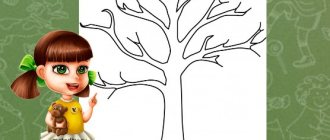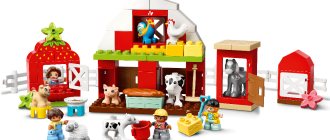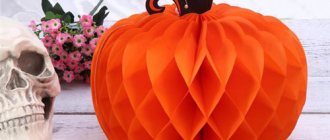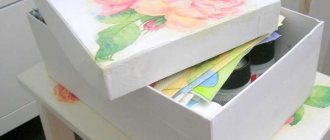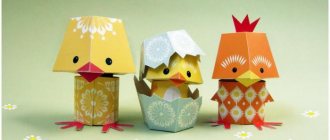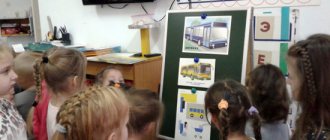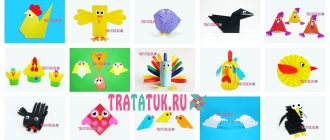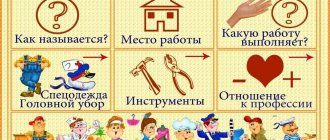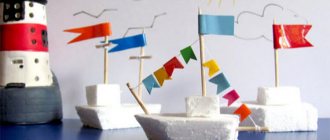Creative machines - paper crafts (full instructions)
We accumulate quite a lot of tubes after using toilet paper. And if we used to throw them away, now we decided to make crafts out of them. The results were such wonderful machines. Do you want the same? Let's get started!
We will need:
- Scissors or knife
- Glue
- Brush
- Toilet paper tubes
- Acrylic paints
- Cardboard
- White and colored paper (for decoration)
- Small nails or buttons
- Pencil
"Bus for Animals" Summary of a design lesson in the middle group
"Bus for Animals" Summary of a design lesson in the middle group
Topic: “Bus for friends.”
Target:
teach children to make an image of a bus from ready-made parts (windows, doors, wheels).
To develop their skills in folding a sheet of paper in half, aligning the sides and corners.
Strengthen the ability to glue paper parts (windows, doors, wheels) to a reference line.
Develop eye, clarity of hand movements, attention.
To instill accuracy in work in preschoolers.
Preliminary work: examination of the observation album “Buses”. Learning the song “Blue Bus”.
Materials for each child: blank bus body (sheet of cardboard with cut corners, 5 pcs squares (windows, 2 pcs strips (bus dividing strip, 2 pcs short strips (doors), 2 pcs triangles (front windows, 4 pcs circles (wheels, glue stick, napkins) , carved animal figures.
Contents of direct educational activities:
Children sit on modules. There's a knock on the door. The postman comes and brings a letter.
Educator: - Guys, we have a letter. Let's see who it's from. It was the inhabitants of the forest who sent us a letter. They really want to come to us for the Autumn holiday, but no transport goes to their forest. They ask us to help them get to our kindergarten. Shall we help?
-Guys, let's think about what types of transport you know? Children's answers: plane, helicopter, car, etc.
-Well done guys, you know many types of transport. But the animals wrote a clue in a letter to us:
What kind of miracle is the long house?
There are a lot of passengers in it
Wears rubber shoes
And it runs on gasoline.
(Bus) .
— That’s right, guys, this is a bus (the teacher takes a large paper bus out of the envelope). How can we help animals? I only have one bus, but there are many residents.
Children's answers: make more buses.
-What a great idea, let's make buses.
But first, let's look at the bus. What parts does the bus consist of? Children's answers: body, windows, doors, wheels. Where are they located?
Right. Now we will sit down at the tables. Each of you has blanks of bus parts. Let's look at them and try to put everything in its place. What will we make the body from (from a large sheet of cardboard). That's right, we need to bend it in half. So that the sides and corners touch each other.
-What shape will we make wheels (circles) from? How many are there? (4)
-Why do you think you have two long stripes? Right. To divide each side of the bus into two equal parts - in half.
-Why are there two short strips (doors)?
-What geometric shapes will you make windows from (squares and triangles).
-And what will serve as wheels (circles) for us? The wheels on both sides are at the same distance opposite each other. Pair.
Please note that on one side the bus has doors, but on the other there are no doors.
So we laid out the parts of the bus. Now let's secure it all with glue.
Educator: Guys, there are still images of animals in the envelope. Let's put every animal on the bus. Children stick pictures on bus windows.
-What a great fellow you are, you made wonderful buses. Let's play with them.
Game "Traffic lights and cars"
— Guys, you did a very useful thing today. You helped the animals get to the Autumn festival in our garden. Tell me, did you like designing buses? Well done.
The animals are very grateful to you and give you treats (juice) for this.
Get text
Paper origami machines (diagrams)
Origami racing car
Such cars were popular in the USSR. We also post a video:
Origami tank
Origami machine
Preview:
SUMMARY OF NODES FOR CONSTRUCTION FROM WASTE MATERIAL
IN THE SENIOR GROUP
V-l: Nikitina M.Yu.
Car construction diagram:
SUMMARY OF NODES FOR CONSTRUCTION FROM WASTE MATERIAL
IN THE SENIOR GROUP
– Expand ideas about machines and their importance in human life.
– Introduce children to construction techniques from waste material (matchboxes).
– Creating conditions for the development of research skills in children.
– Learn to analyze your activities.
– Learn to create transport models according to the diagram.
– Consolidate knowledge of traffic rules.
– Develop attention, memory, thinking, creative imagination
– To develop children’s interest in design.
– Ability to work from a drawing.
– Develop the ability and desire to see things through to completion.
– Cultivate friendly relationships between children.
Demonstration: Slides depicting various types of passenger transport, car models.
Handout: Matchboxes, PVA glue, brushes, napkins, scissors, colored paper, stickers, car craft diagram.
Riddles about transport, looking at slides, pictures, talking with children, watching videos on assembling cars.
The children are offered drawings that depict the sequence of constructing passenger cars from matchboxes. Children look at the drawings, analyze the design and select the necessary material for constructing the transport, and sit down to do the work. Teacher helps struggling children with advice
MANUFACTURING A PASSENGER CAR MODEL:
– gluing a truck body (from matchboxes)
– glue the body to the cab
– cut and glue the wheels
The guys brought us a telegram today - (reads)
“Thank you for the trucks you made for us. But we need your help again. We will soon have a car rally. Please help us and make us cars.
Educator: - Well, guys, can we help? (Yes)
But first we will prepare our fingers for work.
Finger gymnastics “Transport”
Cars are walking along the highway (turn an imaginary steering wheel.)
Tires are rolling on the asphalt. (elbows pressed to the body, palms moving parallel to each other).
Don’t run along the road, (they shook a finger.)
I'll tell you: "Beep." (hand clenched into a fist, thumb straightened - “signal”)
Educator: Today I again invite you to make cars from matchboxes.
The following is a verbal instruction from the teacher regarding the sequence of work:
1. We cover the matchboxes with colored paper.
2. Glue two matchboxes, then glue the third one on top.
(fixed by hand for better gluing of parts).
3. We glue windows, wheels, and headlights from ready-made blanks.
We wait until the glue dries and all the parts are securely fastened.
Children work at tables. Individual work with children experiencing difficulties.
Educator: - I see that many of you have already made cars.
You can go to a rally. Whoever arrives at the finish line first will receive a prize.
Let's send them to the parking lot and clean up their work areas (putting away glue, napkins, remaining paper on their trays).
Acting out: the cars go to the parking lot, the children talk about the cars they made and their purpose.
Educator: - Well, guys, you all worked hard today. What good deed have you done? (children's answers).
Educator: - Did you like making a passenger car?
